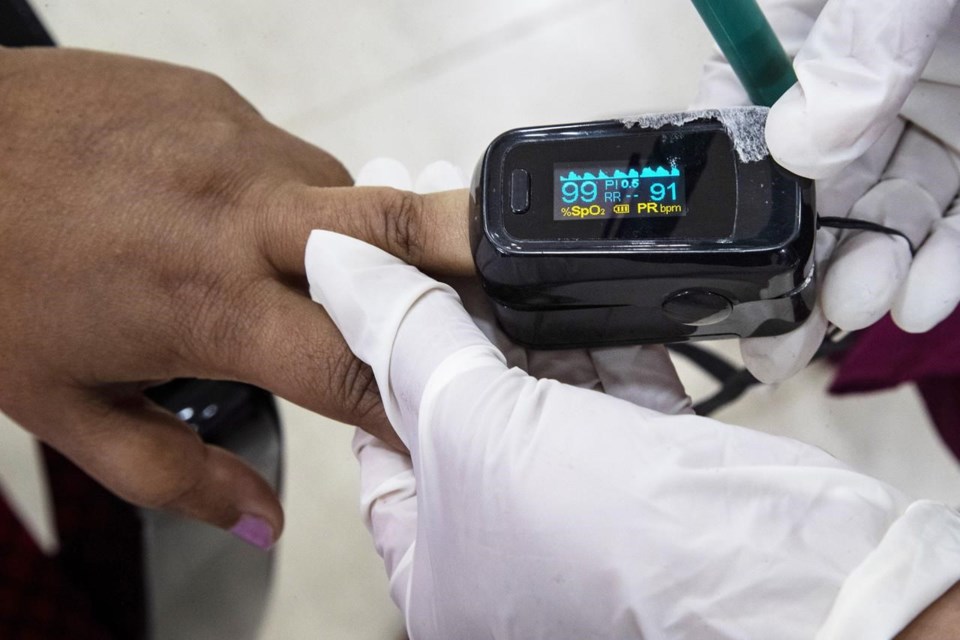NEW YORK (AP) ŌĆö The clip-on devices that use light to measure oxygen levels in the blood are getting a closer look from U.S. regulators after recent studies suggest they don't work as well for patients of color.
The devices, called pulse oximeters, usually snap onto a finger and are widely used in hospitals across the globe to help guide treatment. At-home versions became popular during the COVID-19 pandemic.
But several recent studies have raised concerns that the pigmentation in peopleŌĆÖs skin can throw off the readings. In 2021, the Food and Drug Administration issued a warning about possible inaccuracies after a found the devices tended to overestimate Black patientsŌĆÖ oxygen levels.
ŌĆ£The fact that such a commonly used device could have any discrepancy at all was shocking to me,ŌĆØ said Michael Sjoding, a University of Michigan pulmonologist who led the study. ŌĆ£I make a lot of medical decisions based on this device.ŌĆØ
The FDA has convened a panel of experts to meet Tuesday to discuss ŌĆ£ongoing concerns" about the devices, recommendations for patients and doctors, and ways to gauge accuracy.
Jeff Shuren, director of the FDAŌĆÖs Center for Devices and Radiological Health, called racial disparities in these devices ŌĆ£of great public health importance" at the beginning of the meeting Tuesday. He stressed the need to make sure medical devices are safe and effective for all the groups who use them.
Oxygen levels can also be measured by drawing blood out of an artery in the wrist. This method is still the ŌĆ£gold standardŌĆØ for accuracy, but is a bit trickier and more painful so canŌĆÖt be done as often, said Leo Celi, a physician and MIT researcher who is studying pulse oximetry.
By comparison, pulse oximeters are quicker, easier and less invasive.
When the device snaps onto a finger, it sends two wavelengths of light into the skin, explained Rutendo Jakachira, a doctoral student at Brown University who is researching pulse oximetry. By measuring how much of that light is absorbed, the pulse oximeter estimates how much oxygen is flowing through the blood.
The problem: Melanin ŌĆö a natural pigment responsible for skin tone ŌĆö also absorbs light, Jakachira said. And if devices arenŌĆÖt built with melanin in mind, the extra absorption can throw off their readings.
Mounting evidence suggests this seems to be affecting the pulse oximeters on the market.
SjodingŌĆÖs study found that compared to white patients, Black patients in the hospital were almost three times as likely to experience ŌĆ£occult hypoxemiaŌĆØ ŌĆö meaning their oxygen levels calculated from blood draws were dangerously low, but their pulse oximeter readings were still normal.
Follow-up research showed these errors can have real impacts on health. When patients didnŌĆÖt have their low oxygen levels recognized, it meant , and a , according to several recent studies.
All of these outcomes affected patients of color more often, the research found. For many doctors, the idea that the tools they rely on could be adding to racial discrepancies came as a shock.
ŌĆ£These are fundamental vital signs that we use for patient care,ŌĆØ Sjoding said. ŌĆ£And so if the device is even a small bit less accurate in a particular group of patients, thatŌĆÖs going to have consequences.ŌĆØ
Small studies in past decades had hinted that skin tone might pose a challenge for the devices, but the concerns apparently ŌĆ£fell by the wayside,ŌĆØ said Johns Hopkins physician Ashraf Fawzy, who led one of the recent pulse oximeter studies. He and other doctors said they had never learned about racial gaps in pulse oximeters during their medical training.
But the COVID-19 pandemic brought more attention to the devices ŌĆö and to issues of racial inequality in the health system.
ŌĆ£Now weŌĆÖre more acutely aware of how health care disparities impact people of color,ŌĆØ Fawzy said. ŌĆ£WeŌĆÖre really motivated to actually solve these problems, and make health care more equitable for everyone.ŌĆØ
Some device companies have pushed back on the suggestion that their pulse oximeters are less accurate for patients of color.
Masimo CEO Joe Kiani, whose company sells pulse oximeters to hospitals, said an internal review of their devices didnŌĆÖt find evidence of a significant difference in accuracy for Black patients. He says other variables, like a delay between pulse oximeter readings and blood draws, might have affected recent studies of pulse oximeter accuracy.
Still, others are developing new devices that aim to work better for different skin tones.
Jakachira and her advisor, Kimani Toussaint, are working on a modified pulse oximeter that still shines light into the skin to measure oxygen, but looks at different properties of that light.
While technological solutions are still in the works, experts say it is important for health care workers to know the readings can be inaccurate. Sjoding said heŌĆÖs started to rely less on pulse oximeter readings in his own practice. He still uses them, but as one data point that may not be perfect.
Some experts hoped that updated testing guidance from the FDA ŌĆö like more specific rules on who should be included in studies ŌĆö could help make sure future pulse oximeters work for everyone. The suggest at least 15% of a trial group should have ŌĆ£darkly pigmentedŌĆØ skin.
It may be an ŌĆ£uphill battleŌĆØ to change devices like the pulse oximeter, said A. Ian Wong, a pulmonary critical care doctor at Duke University ŌĆö but he thinks itŌĆÖs a necessary step to provide equal care to all patients.
ŌĆ£Medicine is a bit of an art and a science,ŌĆØ Wong said. ŌĆ£ItŌĆÖs more than just how a doctor practices; itŌĆÖs also the tools you use.ŌĆØ
ŌĆöŌČ─öŌČ─ö
The Associated Press Health and Science Department receives support from the Howard Hughes Medical InstituteŌĆÖs Department of Science Education. The AP is solely responsible for all content.
Maddie Burakoff, The Associated Press



